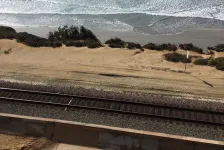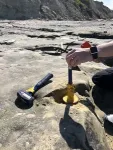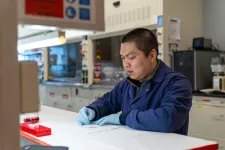(Press-News.org) In parts of California’s iconic mountainous coasts, breathtaking beauty is punctuated by brusque signs warning spectators to stay back from unstable cliffs. The dangers of coastal erosion are an all-too-familiar reality for the modern residents of these communities. Now, with a new tool, researchers are bringing historical perspective to the hotly debated topic of how to manage these disappearing coastlines.
Using a model that incorporates measurements of the amount of time coastal cliffs and their remnant deposits were exposed at the Earth’s surface, Stanford researchers found that the rate of cliff erosion in the past 100 years is similar to that of the past 2,000 years. The proof-of-concept, published in the Journal of Geophysical Research: Earth Surface April 17, opens the possibility of using this new approach to understand the long-term history of coastal cliff erosion, or retreat, in other parts of the state. The work was conducted in Del Mar, California, a beach town in San Diego County with infrastructure atop its coastal bluffs.
“In this particular location, these cliff erosion rates have been the same for thousands of years, so we shouldn’t expect them to get lower,” said senior study author Jane Willenbring, an associate professor of Earth and planetary sciences at the Stanford Doerr School of Sustainability. “If anything, we should expect them to be higher in the future.”
Del Mar is among locations that are critically important for understanding cliff retreat. Homes are situated up to 70 feet above its beach, in addition to public infrastructure. A major railroad between Los Angeles and San Diego runs atop the coastal bluffs, where cliff failures have resulted in several derailments in modern history, as well as rock fall events that led to closures in recent years.
“I think this study bolsters the thinking that we should do something about cliff retreat sooner rather than later,” said lead study author Travis Clow, PhD ’22.
A natural laboratory
The study area was ideal for the researchers’ methodology because the Del Mar beach features a narrow shore platform, the bedrock where tidepools are typically found. Using nine samples of bedrock, the co-authors measured concentrations of the chemical isotope beryllium-10 that track landform exposure to cosmic radiation from space. The data were compared with cliff retreat rates from recent studies based on aerial photography, showing that coastal erosion rates have remained relatively constant over the past two millennia – at about 2 to 5 inches per year.
“One of the advantages of this technique is that it gives you information at the time scales that are relevant for factors like sea-level rise,” Willenbring said. “Our tool estimates retreat over time periods that include multiple major storms or atmospheric rivers that don’t happen very often, but are critical in forming the coastline.”
The researchers’ approach explores the influence of different factors, including wave impacts and weathering that occur at the shore platform and the cliff interface.
“It does more than just spit out a retreat rate,” said Clow, who processed the samples in Willenbring’s lab and measured them at the Center for Accelerator Mass Spectrometry at Lawrence Livermore National Laboratory (LLNL). “It also allows us to have a relative assessment of what might be driving cliff retreat over longer periods of time.”
When rock becomes air
On sandy coasts, like those spanning much of the eastern U.S., beaches are shaped by waves that pull sand out to the ocean, then re-deposit it on land with the coming and going of the tides. But with rocky coastlines like those along California, once a cliff erodes into the ocean, it cannot be replaced, Willenbring said. Instead, it’s as if the rock becomes air.
Willenbring was surprised to learn through this research that over half of all coastlines on Earth are eroding like California’s. The scope of the problem, which will be exacerbated by sea-level rise in the next century, presents an opportunity for using this new technique in other areas.
“There are plenty of other places in California and the Pacific Northwest where active erosion of coastal rocky cliffs is happening, and we hope to use this technique in a wide variety of environments,” Clow said.
Knowledge of cliff retreat in the U.S. is about 50 years behind research on the impacts of erosion and storms on sandy beaches, according to Willenbring – and that makes her excited about contributing to fundamental science in this field.
“No one had even looked at how the beach width correlated with the rate of cliff retreat in California,” Willenbring said. “There are a lot of open questions about what drives coastal erosion, and now we have a new tool to be able to address some of them.”
Additional study co-authors are from the Scripps Institution of Oceanography at the University of California, San Diego; the Center for Accelerator Mass Spectrometry at LLNL; and Imperial College London. The research was supported by LLNL, the California Department of Parks and Recreation, and the U.S. Army Corps of Engineers.
END
New approach estimates long-term coastal cliff loss
2023-04-17
ELSE PRESS RELEASES FROM THIS DATE:
Long Covid smell loss linked to changes in the brain
2023-04-17
People living with long Covid who suffer from loss of smell show different patterns of activity in certain regions of the brain, a new study led by UCL researchers has found.
The research used MRI scanning to compare the brain activity of people with long Covid who lost their sense of smell, those whose smell had returned to normal after Covid infection, and people who had never tested positive for Covid-19.
Published in eClinicalMedicine, the observational study found that the people with long Covid smell loss had reduced brain activity and impaired communication between two parts of the brain which process ...
Southwest Research Institute’s automotive engineering expertise on display at SAE International’s WCX™ 2023
2023-04-17
SAN ANTONIO — April 17, 2023 —Southwest Research Institute staff members have converged upon Detroit this week to share their respective expertise with the mobility industry at the 2023 SAE International WCX™ World Congress Experience.
WCX is the “largest technical mobility event developed by the industry, for the industry,” according to SAE. The conference, which takes place April 17-20, invites mechanical, electrical and software engineers working in mobility from around the world to share knowledge and research to overcome the latest challenges facing the industry.
As leaders in mobility and automotive research, ...
Adapting apples to the times
2023-04-17
Through careful crossbreeding and selection, University of Maryland researchers have developed what may just be the perfect apples for American growers trying to adapt to a changing world. The two new apples, a yellow and a red one are heat-tolerant, blight-tolerant, low-maintenance, easy to harvest and not least, delicious-tasting. Both have been approved for patents and are awaiting the final grant from the U.S. Patent Office.
They address a growing suite of problems the apple industry has been grappling with. The fruit has always been labor-intensive to bring to market, with trees that need to be trained, pruned, ...
Extended monitoring detects more arrhythmias in hypertrophic cardiomyopathy
2023-04-17
Barcelona, Spain – 17 April 2023: Thirty day electrocardiogram (ECG) monitoring in patients with hypertrophic cardiomyopathy (HCM) detects more arrhythmias than the standard 24 to 48 hours, according to late breaking science presented at EHRA 2023, a scientific congress of the European Society of Cardiology (ESC).1
Up to 20% of patients with HCM develop atrial fibrillation during the course of the disease2,3 and are at particularly high risk of stroke. Therefore, guidelines do not recommend the CHA2DS2-VASc score4 to calculate stroke risk but advise starting anticoagulant treatment in all patients with HCM ...
Vilcek Foundation awards $50,000 prize to immigrant biochemist Edward Chouchani
2023-04-17
Edward Chouchani receives a Vilcek Prize for Creative Promise in Biomedical Science for his work to decipher the molecular mechanisms that drive metabolic disease, with the aim of developing therapeutic interventions.
The Vilcek Prize for Creative Promise is a $50,000 recognition awarded annually by the Vilcek Foundation as part of its prizes program. Awarded annually since 2006, the Vilcek Foundation prizes recognize and celebrate immigrant contributions to scientific research and discovery, and to artistic and cultural advancement in the United States. The Vilcek Foundation prizes support the Vilcek Foundation’s mission to raise public awareness of the value ...
A solar hydrogen system that co-generates heat and oxygen
2023-04-17
A parabolic dish on the EPFL campus is easily overlooked, resembling a satellite dish or other telecommunications infrastructure. But this dish is special, because it works like an artificial tree. After concentrating solar radiation nearly 1,000 times, a reactor above the dish uses that sunlight to convert water into valuable and renewable hydrogen, oxygen, and heat.
“This is the first system-level demonstration of solar hydrogen generation. Unlike typical lab-scale demonstrations, it includes all auxiliary devices and components, so it gives us a better idea of the energy efficiency you can expect ...
Methane from megafires: more spew than we knew
2023-04-17
Using a new detection method, UC Riverside scientists found a massive amount of methane, a super-potent greenhouse gas, coming from wildfires — a source not currently being accounted for by state air quality managers.
Methane warms the planet 86 times more powerfully than carbon dioxide over the course of 20 years, and it will be difficult for the state to reach its required cleaner air and climate goals without accounting for this source, the researchers said.
Wildfires emitting methane ...
Salmonella solution
2023-04-17
McMaster University researchers have developed a rapid and inexpensive test for Salmonella contamination in chicken and other food – one that’s easier to use than a home COVID test.
The test, described in a new paper in the journal Angewandte Chemie, could improve food safety, reduce the cost of processing fresh poultry and other foods, and help to limit broad recalls to batches that have specifically been identified as contaminated.
The researchers have shown that the test provides accurate results in an hour or less without the need for accessories or a power source, compared ...
New genetic target for male contraception identified
2023-04-17
PULLMAN, Wash. – Discovery of a gene in multiple mammalian species could pave the way for a highly effective, reversible and non-hormonal male contraceptive for humans and animals.
Washington State University researchers identified expression of the gene, Arrdc5, in the testicular tissue of mice, pigs, cattle and humans. When they knocked out the gene in mice, it created infertility only in the males, impacting their sperm count, movement and shape. The researchers detailed their findings in the journal Nature Communications.
“The study identifies this gene for the first time as being expressed ...
The annual report on antisemitism worldwide – 2022: Haredi Jews – The main target of antisemitic assaults
2023-04-17
Embargoed until Monday, April 17th at 11AM (Israel time)
On the eve of Holocaust Remembrance Day
Tel Aviv University in cooperation with the Anti-Defamation League (ADL) presents
The Annual Report on Antisemitism Worldwide – 2022:
Haredi Jews – The Main Target of Antisemitic Assaults
2002 saw another sharp increase in the number of antisemitic incidents in the United States and other Western countries, alongside a decline in several other countries, including France, Germany, and the United Kingdom.
The report found that Haredi Jews are the main victims of antisemitic assaults in the West. Physical attacks, which ...







